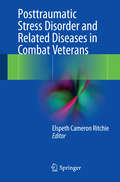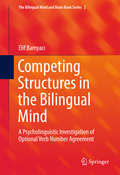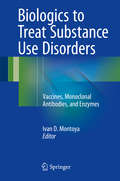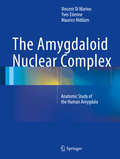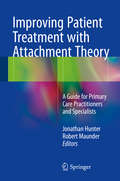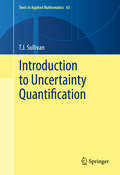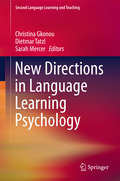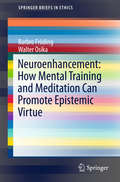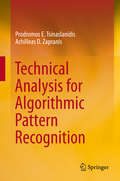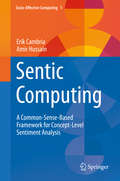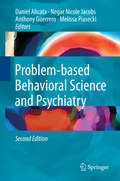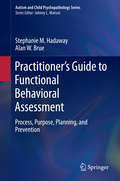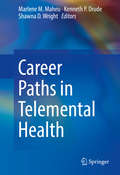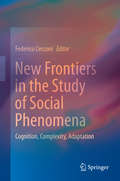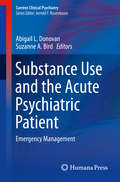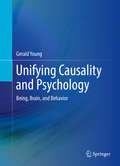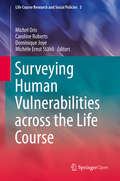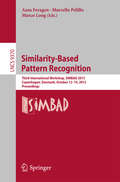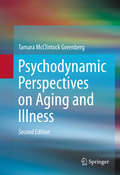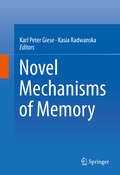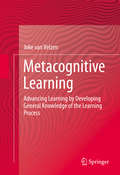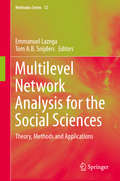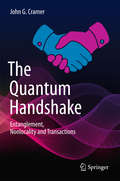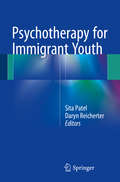- Table View
- List View
Posttraumatic Stress Disorder and Related Diseases in Combat Veterans
by Elspeth Cameron RitchieThis book takes a case-based approach to addressing the challenges psychiatrists and other clinicians face when working with American combat veterans after their return from a war zone. Written by experts, the book concentrates on a wide variety of concerns associated with posttraumatic stress disorder (PTSD), including different treatments of PTSD. The text also looks at PTSD comorbidities, such as depression and traumatic brain injury (TBI) and other conditions masquerading as PTSD. Finally, the authors touch on other subjects concerning returning veterans, including pain, disability, facing the end of a career, sleep problems , suicidal thoughts, violence, , and mefloquine "toxidrome". Each case study includes a case presentation, diagnosis and assessment, treatment and management, outcome and case resolution, and clinical pearls and pitfalls. Post-Traumatic Stress Disorder and Related Diseases in Combat Veterans is a valuable resource for civilian and military mental health practitioners, and primary care physicians on how to treat patients returning from active war zones.
Competing Structures in the Bilingual Mind: A Psycholinguistic Investigation of Optional Verb Number Agreement (The Bilingual Mind and Brain Book Series #2)
by Elif BamyacıThis volume combines psycholinguistic experiments with typological investigations in order to provide a comprehensive exploration of the linguistic structure of verb-number agreement in bilingual speakers, with a particular focus on the Turkish language. It takes as its starting point the question of which linguistic structures pose difficulties for bilingual speakers, and then proceeds to evaluate the question by using the interface phenomenon of optional verb number agreement. In doing so, this volume investigates how the bilingual mind handles grammatical structures that demand high processing sources, working towards a processing-based linguistic framework for the bilingual mind. Beginning with a thorough survey of the current research of the interface phenomenon in the bilingual mind, the volume then proceeds to present two separate studies on each linguistic interface type, namely semantics-syntax interface and syntax-pragmatics interface, thus filling a number of gaps in the bilingualism research with regards to the interface phenomenon The results and conclusions of these studies are then integrated with current knowledge and research from the field within a theoretical and processing-based framework in order to explore new psycholinguistic insights for the bilingual mind, specifically the conclusion that the grammar of bilingual speakers is shaped according to cross linguistic tendencies. Ultimately, it provides a unified account and a comprehensive conclu sion regarding the non-native-like patterns in grammar of bilingual speakers. Serving as a fascinating and timely resource, Competing Structures in the Bilingual Mind: An Investigation of Optional Verb Number Agreement will appeal to bilingualism researchers, clinical linguists, cognitive scientists, experimental linguists, and any linguist specializing in Turkic or Altaic languages.
Teacher Beliefs as a Complex System: English Language Teachers in China
by Hongying ZhengThe volume is a practical introduction to the ways in which the teachers deal with classroom events in the context of change for researchers, teachers, administrators who wish to implement curriculum reform to EFL in schools. The author provides insights into the beliefs of Chinese teachers of English as a Foreign Language (EFL), and their pedagogical choices in the context of the National English Curriculum Reform. The complex nature of EFL teachers' beliefs about EFL teaching and learning are exposed, how their beliefs interact with mental and actionable processes triggered by classroom practice, and how their beliefs co-adapt with contexts to maintain the stability of the teachers' belief systems. This is the first study to present complexity theory in a narrative context of education, exploring the non-linear and unpredictable features of the relationship between the teachers' beliefs and practices. Integrating complexity theory with interpretivist, ecological and sociocultural perspectives, this book contributes to the research agenda by providing a systematic framework for examining teacher beliefs as a whole, and examining the extent to which western theory may be applied to Chinese educational contexts.
Biologics to Treat Substance Use Disorders: Vaccines, Monoclonal Antibodies, and Enzymes
by Ivan D. MontoyaThis book is a scientific compendium documenting the state of the art in the discovery and development of vaccines, monoclonal antibodies, and enzymes for the treatment of Substance Use Disorders (SUDs). The book gives detailed consideration to some of the most cutting edge topics in addiction medicine, including vaccines for nicotine, cocaine, heroin, and methamphetamine dependence; monoclonal antibodies against cocaine, methamphetamine, and phencyclidine; and the enzymes butyrylcholinesterase and cocaine esterase. In addition, the text covers a wide range of new strategies designed to optimize the development and efficacy of biologics. Unlike any other resource, this book reviews how biologics offer exciting new therapeutic opportunities for various psychiatric conditions. Written by experts in the field, Biologics to Treat Substance Use Disorders is as an authoritative reference for psychiatrists, psychologists, and all other medical professionals working with patients suffering from Substance Use Disorders.
The Amygdaloid Nuclear Complex
by Vincent Di Marino Yves Etienne Maurice NiddamThis timely book allows clinicians of the nervous system, who are increasingly confronted with degenerative and psychiatric diseases, to familiarize themselves with the cerebral amygdala and the anatomical structures involved in these pathologies. Its striking photos of cerebral sections and dissections should help MRI specialists to more precisely study the detailed images provided by their constantly evolving equipment.
Improving Patient Treatment with Attachment Theory
by Robert Maunder Jonathan HunterThis book emphasizes interpersonal relationships as a frequently overlooked, yet crucial element in today's healthcare system and describes the utility of attachment theory in understanding and managing patients with medical and surgical illness. Sections on the fundamentals of attachment theory, specific patient populations, attachment-based interventions, and future directions comprehensively reflect our current knowledge. The summarized research demonstrates the value of attachment theory in approaching such common issues as non-adherence, strain in the healthcare worker-patient relationship, and somatoform complaints, as well as in modelling maladaptive stress responses and subsequent illness vulnerability. The contributing authors are internationally recognized researchers and teachers who have sought to make this volume accessible to anyone interested in using the positive aspects of interpersonal relationships to maximum advantage in the practice of healthcare.
Introduction to Uncertainty Quantification
by T. J. SullivanThis text provides a framework in which the main objectives of the field of uncertainty quantification (UQ) are defined and an overview of the range of mathematical methods by which they can be achieved. Complete with exercises throughout, the book will equip readers with both theoretical understanding and practical experience of the key mathematical and algorithmic tools underlying the treatment of uncertainty in modern applied mathematics. Students and readers alike are encouraged to apply the mathematical methods discussed in this book to their own favorite problems to understand their strengths and weaknesses, also making the text suitable for a self-study. Uncertainty quantification is a topic of increasing practical importance at the intersection of applied mathematics, statistics, computation and numerous application areas in science and engineering. This text is designed as an introduction to UQ for senior undergraduate and graduate students with a mathematical or statistical background and also for researchers from the mathematical sciences or from applications areas who are interested in the field. T. J. Sullivan was Warwick Zeeman Lecturer at the Mathematics Institute of the University of Warwick, United Kingdom, from 2012 to 2015. Since 2015, he is Junior Professor of Applied Mathematics at the Free University of Berlin, Germany, with specialism in Uncertainty and Risk Quantification.
New Directions in Language Learning Psychology
by Sarah Mercer Christina Gkonou Dietmar TatzlThis book explores potential new directions in the growing field of language learning psychology. The individual chapters cover theoretical and conceptual developments and innovative methodological designs, while also exploring practical implications. Language learning psychology is a vibrant field of research that typically involves constructs from social and educational psychology, which it considers in terms of their relevance for the domain of language learning. The diverse theoretical and empirical chapters examine a range of familiar and lesser-known constructs, highlighting the importance of taking into account both learner and teacher psychologies, and recognising the complexity, dynamism and situatedness of psychological constructs, as well as the value of employing diverse research methodologies. It is hoped that these 'new directions' concerning populations, constructs and theoretical and methodological frameworks will pave the way for innovative future developments in this vibrant field.
Neuroenhancement: how mental training and meditation can promote epistemic virtue.
by Barbro Fröding Walter OsikaThis book explores how one can bring about changes in the brain through meditation, both through attention-focus training and through compassion training. Recent findings in the natural sciences have confirmed that it is possible for humans to achieve these structural and functional changes through various life-style practices. It is argued that meditation enables us to influence some aspects of our biological make-up and, for example, could boost our cognitive flexibility as well as our ability to act compassionate. Such changes are likely to facilitate the instilling of a number of epistemic virtues which have great bearing on our quality of life. This book offers the reader an accessible introduction to a set of neuro-enhancement methods, with a special focus on meditation techniques, and explores how such practices could contribute to make us better decision-makers and improve our moral virtues. The book is suitable for anyone looking for a text discussing the effects of neuro-enhancement from a secular ethics perspective.
Technical Analysis for Algorithmic Pattern Recognition
by Achilleas D. Zapranis Prodromos E. TsinaslanidisThe main purpose of this book is to resolve deficiencies and limitations that currently exist when using Technical Analysis (TA). Particularly, TA is being used either by academics as an "economic test" of the weak-form Efficient Market Hypothesis (EMH) or by practitioners as a main or supplementary tool for deriving trading signals. This book approaches TA in a systematic way utilizing all the available estimation theory and tests. This is achieved through the developing of novel rule-based pattern recognizers, and the implementation of statistical tests for assessing the importance of realized returns. More emphasis is given to technical patterns where subjectivity in their identification process is apparent. Our proposed methodology is based on the algorithmic and thus unbiased pattern recognition. The unified methodological framework presented in this book can serve as a benchmark for both future academic studies that test the null hypothesis of the weak-form EMH and for practitioners that want to embed TA within their trading/investment decision making processes.
Sentic Computing
by Amir Hussain Erik CambriaIn this book common sense computing techniques are further developed and applied to bridge the semantic gap between word-level natural language data and the concept-level opinions conveyed by these. In particular, the ensemble application of graph mining and multi-dimensionality reduction techniques is exploited on two common sense knowledge bases to develop a novel intelligent engine for open-domain opinion mining and sentiment analysis. The proposed approach, termed sentic computing, performs a clause-level semantic analysis of text, which allows the inference of both the conceptual and emotional information associated with natural language opinions and, hence, a more efficient passage from (unstructured) textual information to (structured) machine-processable data.
Problem-based Behavioral Science and Psychiatry
by Daniel Alicata Negar Jacobs Anthony Guerrero Melissa PiaseckiIn keeping with the growing emphasis on psychiatry in the medical school curriculum, problem-based learning (PBL) offers students a unique patient-centred, multidisciplinary approach to study and the synthesis of knowledge. The new 2nd edition of Problem-Based Behavioral Science and Psychiatry integrates DSM-5 updates and diagnostic criteria, and is fully consistent with PBL models and methods. Building on the strengths of the popular and widely downloaded 1st edition, the 2nd edition is a clinically robust resource for both the medical and the behavioral science student. Over 40 contributors, many themselves graduates of PBL medical schools, apply problem-based learning methods to specific psychiatric disorders, general clinical issues, and bedrock physician skills such as the intake interview and treatment planning. The book's fictional case vignettes illustrated typical patient scenarios, providing real-world context for content areas, and accompanying case diagrams show the relationships between patient behaviour and underlying neurobiological structures. Each student-friendly section ends with helpful review questions. A sampling of the content areas covered: · Childhood development and brain development. · Major psychiatric illnesses, including personality, mood, anxiety, and psychotic disorders. · Stress, substance abuse, and violence. · Eating, sleep, and sexual disorders. · Coping skills and treatment compliance. · End-of-life care. · PLUS chapters on cultural sensitivity, ethical concerns, and the physician/patient relationship. This book is ideal for first and second year medical students wanting to learn about psychiatry in the exciting context of realistic cases. It also makes an excellent prep/review text for third- and fourth-year medical students preparing for the USMLE Step 1 and 2 exams, as well as being suited to graduate students in psychology or clinical social work. Problem-Based Behavioral Science and Psychiatry encourages lifelong learning and helps build the foundation for a lifelong career.
Practitioner's Guide to Functional Behavioral Assessment
by Alan W. Brue Stephanie M. HadawayThis practical guide introduces functional behavioral assessment as a critical tool in planning interventions to reduce disruptive and other problematic behaviors. The book offers proven methods and strategies as a four-stage protocol in an easy-to-follow format with checklists, Q&A sections, applications, and an extended case example including an assessment report and intervention plan. Step-by-step instructions are delivered in an accessible teaching style, making all phases of assessment equally manageable. And although functional behavioral assessment is typically associated with schoolchildren, this material is also useful for working with adults in residential and community settings. The Guide gives readers: The basics of functional behavioral assessment. Guidance in preparing for conducting a functional behavioral assessment. An overview of assessment methods: formal and informal measures, interview, and observation. A framework for translating assessment data into an appropriate intervention plan. In-depth understanding of the role of prevention in behavioral intervention. A kit of questionnaires, worksheets, and other ready-to-use resources. Practitioner's Guide to Functional Behavioral Assessment is an essential resource for clinicians and related professionals as well as researchers and graduate students in school and clinical child psychology; behavior therapy; assessment, testing and evaluation; special education; and educational psychology.
Career Paths in Telemental Health
by Marlene M. Maheu Kenneth P. Drude Shawna D. WrightThis visionary volume spotlights innovative mental healthcareers in today's technology-driven climate while inspiring readers to createtheir own opportunities. Unique and engaging perspectives from professionals acrossdisciplines and job titles describe the thought processes, ingenuity, anddiscipline behind matching technologies to the needs of specific populationsand settings. These non-traditional paths show digital advances as used infrontline, complementary, supplemental, and alternative interventions, in academicand training settings, in private practice, and in systems facing transition. Thediversity of these contributions illustrates the myriad openings technologypresents for both professional fulfillment and clients' improved well-being. Highlights of the coverage: Crisis in the behavioral health classroom: enhancing knowledge, skills, and attitudes in telehealth training. Using technology in behavior analysis: a journey into telepractice. Making iCBT available in primary care settings: bridging the gap between research and regular healthcare. Improving veterans' access to trauma services through clinical video telehealth. Virtual reality therapy for treatment of psychological disorders. Promoting and evaluating evidence-based telepsychology interventions. For mental health practitioners, practitioners in training,researchers, academics, and policymakers, CareerPaths in Telemental Health is an ideabook whose time has come--and continuesto unfold.
New Frontiers in the Study of Social Phenomena
by Federico CecconiThis book studies social phenomena in a new way, by making judicious use of computer technology. The book addresses the entire spectrum of classic studies in social science, from experiments to the computational models, with a multidisciplinary approach. The book is suitable for those who want to get a picture of what it means to do social research today, and also to get an indication of the major open issues. The book is connected to a database of code for simulations, experimental data and allows to activate a subscription to a teaching tool using NetLogo, a programming language widely used in the social studies. The authors are researchers with first-hand experience research projects, both basic and applied. The work will be useful for those who want to understand more of the social, economic and political phenomena via computer applications.
Substance Use and the Acute Psychiatric Patient: Emergency Management (Current Clinical Psychiatry)
by Abigail L. Donovan Suzanne A. BirdThis book fills a gap in the existing medical literature by providing a best-practice approach to the evaluation and acute treatment of patients presenting for emergency care with identifiable substance use and/or co-occurring psychiatric disorders. As the first interdisciplinary book to integrate psychiatric and emergency care, the text uniquely covers a myriad of serious medical conditions, acute mental status and dangerous behavioral abnormalities. The book focuses on guidelines that support emergency room physicians with little formal medical training in addiction medicine. The first section focuses on the diagnosis and management of substance-specific intoxication and withdrawal states, as well as common medical co-morbidities and disposition considerations. The book lends particular attention to the identification and stabilization of high risk medical conditions associated with each substance of abuse. The second section is psychiatrically focused, addressing the most common psychiatric symptoms and syndromes, their association with SUDs, an approach to differential diagnosis, and discussion of crucial treatment considerations for both safe ED management and post-ED disposition. A final section includes other pertinent topics, for example, the assessment of patient safety, responding to the medication-seeking patient, assessment and treatment of pregnant patients and working with adolescents and their families around substance use.Substance Use and The Acute Patient is a unique and valuable contribution to the literature for both consulting psychiatrists, emergency medicine specialists, addiction medicine specialists, and all other medical professionals who provide care for these most complex and underserved patients.
Unifying Causality and Psychology
by Gerald YoungThis magistral treatise approaches the integration of psychology through the study of the multiple causes of normal and dysfunctional behavior. Causality is the focal point reviewed across disciplines. Using diverse models, the book approaches unifying psychology as an ongoing project that integrates genetics, experience, evolution, brain, development, change mechanisms, and so on. The book includes in its integration free will, epitomized as freedom in being. It pinpoints the role of the self in causality and the freedom we have in determining our own behavior. The book deals with disturbed behavior, as well, and tackles the DSM-5 approach to mental disorder and the etiology of psychopathology. Young examines all these topics with a critical eye, and gives many innovative ideas and models that will stimulate thinking on the topic of psychology and causality for decades to come. It is truly integrative and original. Among the topics covered: Models and systems of causality of behavior. Nature and nurture: evolution and complexities. Early adversity, fetal programming, and getting under the skin. Free will in psychotherapy: helping people believe. Causality in psychological injury and law: basics and critics. A Neo-Piagetian/Neo-Eriksonian 25-step (sub)stage model. Unifying Causality and Psychology appeals to the disciplines of psychology, psychiatry, epidemiology, philosophy, neuroscience, genetics, law, the social sciences and humanistic fields, in general, and other mental health fields. Its level of writing makes it appropriate for graduate courses, as well as researchers and practitioners.
Surveying Human Vulnerabilities across the Life Course (Life Course Research And Social Policies Ser. #3)
by Caroline Roberts Michel Oris Dominique Joye Michèle Ernst StähliThis volume details tools and procedures for data collections of hard-to-reach, hard-to-survey populations. Inside, readers will discover first-hand insights from experts who share their successes as well as their failures in their attempts to identify and measure human vulnerabilities across the life course. Coverage first provides an introduction on studying vulnerabilities based on the Total Error Survey framework. Next, the authors present concrete examples on how to survey such populations as the elderly, migrants, widows and widowers, couples facing breast cancer, employees and job seekers, displaced workers, and teenagers during their transition to adulthood. In addition, one essay discusses the rationale for the use of life history calendars in studying social and psychological vulnerability while another records the difficulty the authors faced when trying to set-up an online social network to collect relevant data. Overall, this book demonstrates the importance to have, from the very beginning, a dialogue between specialists of survey methods and the researchers working on social dynamics across the life span. It will serve as an indispensable resource for social scientists interested in gathering and analyzing data on vulnerable individuals and populations in order to construct longitudinal data bases and properly target social policies.
Similarity-Based Pattern Recognition
by Marcello Pelillo Aasa Feragen Marco LoogThis book constitutes the proceedings of the Third International Workshop on Similarity Based Pattern Analysis and Recognition, SIMBAD 2015, which was held in Copenahgen, Denmark, in October 2015. The 15 full and 8 short papers presented were carefully reviewed and selected from 30 submissions. The workshop focus on problems, techniques, applications, and perspectives: from supervised to unsupervised learning, from generative to discriminative models, and from theoretical issues to empirical validations.
Psychodynamic Perspectives on Aging and Illness
by Tamara Mcclintock GreenbergMore than ever, the aging process is recognized as carrying a special set of emotional challenges-especially when acute or chronic medical conditions are involved. In this light, Psychodynamic Perspectives on Aging and Illness presents a fresh, contemporary application of psychodynamic theory, addressing the complex issues surrounding declining health. Informed by the spectrum of psychodynamic thought from self, relational, and classical theories, this forward looking volume offers more modern interpretations of theory, and techniques for working with a growing, complicated, but surprisingly resilient population. It illuminates how to enhance the therapeutic relationship in key areas such as addressing body- and self-image issues, approach sensitive topics, and understand the disconnect that can occur between medical patients and the often impersonal, technology-driven health care system. At the same time, the author cogently argues for pluralism in a therapeutic approach that is frequently threatened by forces both within and outside the field. Among the topics covered: Medical illness as trauma. Idealization and the culture of medicine. Normative and pathological narcissism in the ill and/or aging patient. Noncompliant and self-destructive behaviors. Transference and countertransference issues. Psychotherapy with cognitively impaired adults. Grief, loss, and hope. Expanding on what we know and candid about what we don't, Psychodynamic Perspectives on Aging and Illness offers mental health researchers and practitioners an insightful framework for improving the lives of older patients.
Novel Mechanisms of Memory
by Karl Peter Giese Kasia RadwanskaThis book integrates discoveries from recent years to show the diversity of molecular mechanisms that contribute to memory consolidation, reconsolidation, extinction, and forgetting. It provides a special focus on the processes that govern functional and structural plasticity of dendritic spines. In nine chapters, new and important ideas related to learning and memory processes will be presented. Themes discussed include the role of AMPA receptors in memory, two signalling cascades involved in local spine remodelling and memory, the role of extracellular matrix proteins in memory, the regulation of gene expression and protein translation, and mechanisms of retrieval-induced memory modulation and forgetting. We believe that the study of these topics represents a great step toward understanding the complexity of the brain and the processes it governs.
Metacognitive Learning
by Joke Van VelzenIn this book, the educational theory of metacognitive learning and its instructional implications are used to describe and illustrate how learners can become effective or self-directive learners. First, three levels of general knowledge of the learning process are discussed in this book through an overview of research studies. The book then describes how learners can develop along these levels and learn to effectively plan their learning. This book includes study and educational material centered on the learning and instruction of general knowledge of the learning process.
Multilevel Network Analysis for the Social Sciences
by Emmanuel Lazega Tom A.B. SnijdersThis volume provides new insights into the functioning of organizational, managerial and market societies. Multilevel analysis and social network analysis are described and the authors show how they can be combined in developing the theory, methods and empirical applications of the social sciences. This book maps out the development of multilevel reasoning and shows how it can explain behavior, through two different ways of contextualizing it. First, by identifying levels of influence on behavior and different aggregations of actors and behavior, and complex interactions between context and behavior. Second, by identifying different levels as truly different systems of agency: such levels of agency can be examined separately and jointly since the link between them is affiliation of members of one level to collective actors at the superior level. It is by combining these approaches that this work offers new insights. New case studies and datasets that explore new avenues of theorizing and new applications of methodology are presented. This book will be useful as a reference work for all social scientists, economists and historians who use network analyses and multilevel statistical analyses. Philosophers interested in the philosophy of science or epistemology will also find this book valuable.
The Quantum Handshake
by John G. CramerThis book shines bright light into the dim recesses of quantum theory, where the mysteries of entanglement, nonlocality, and wave collapse have motivated some to conjure up multiple universes, and others to adopt a "shut up and calculate" mentality. After an extensive and accessible introduction to quantum mechanics and its history, the author turns attention to his transactional model. Using a quantum handshake between normal and time-reversed waves, this model provides a clear visual picture explaining the baffling experimental results that flow daily from the quantum physics laboratories of the world. To demonstrate its powerful simplicity, the transactional model is applied to a collection of counter-intuitive experiments and conceptual problems.
Psychotherapy for Immigrant Youth
by Daryn Reicherter Sita PatelThis book provides an in-depth, practical, and cutting-edge summary of psychotherapy for immigrant children and adolescents. This text integrates practical therapeutic methods with current empirical knowledge on the unique life stressors and mental health concerns of immigrant youth, proving essential for all who seek to address the psychological needs of this vulnerable and under-served population. Specific chapters are devoted to trauma, refugees and forced displacement, cognitive-behavioral therapy, psychopharmacological issues, school-based treatment, family. Each chapter includes specific cultural concerns and treatment techniques for immigrant groups from various regions of the world. In-depth case examples illustrate case formulation, how and when to use specific techniques, challenges faced in the treatment of immigrant youth, and responses to common obstacles. With detailed theory and practice guidelines, Psychotherapy for Immigrant Youth is a vital resource for psychologists, psychiatrists, social workers, and other practitioners.
